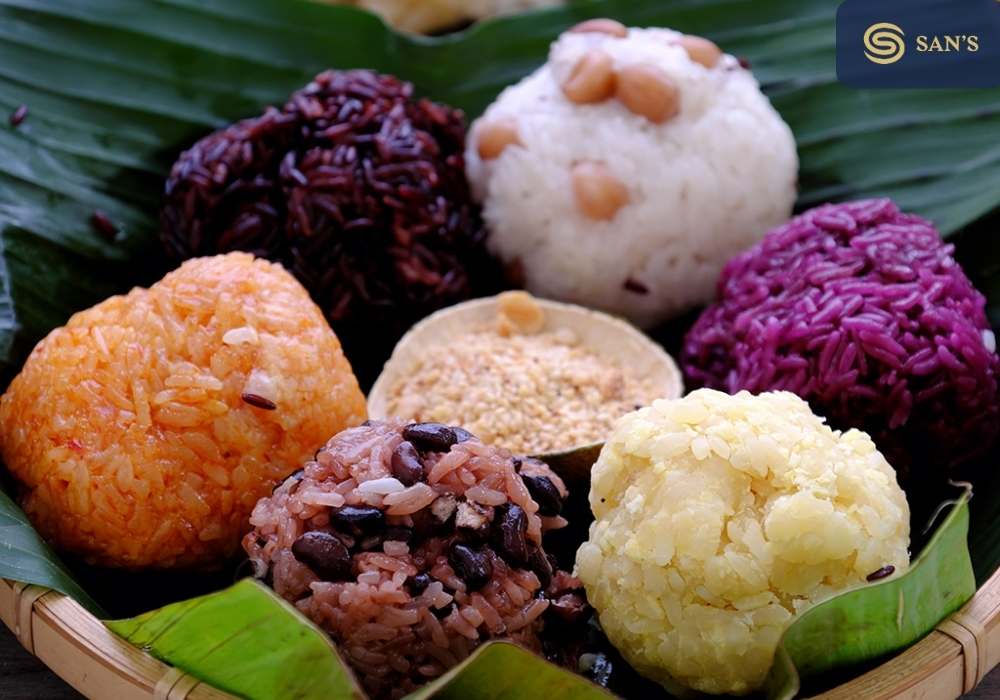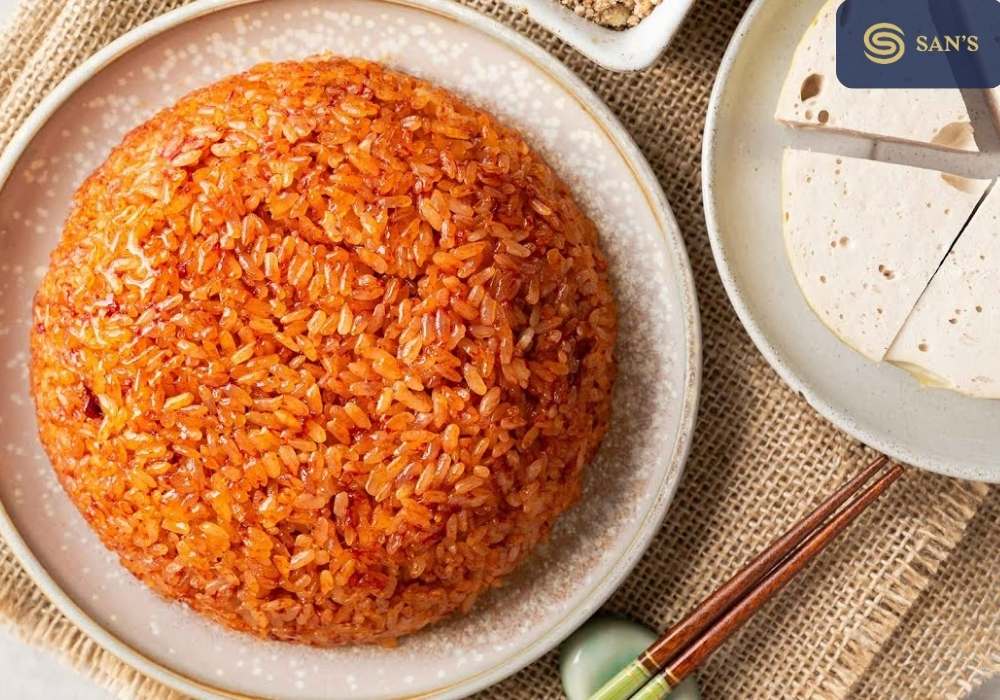Explore how to make Vietnamese sticky rice with our detailed guide. From choosing ingredients to perfecting the technique, we’ve got you covered.
But Vietnamese sticky rice isn’t just revered for its taste. The rituals, from soaking the rice grains to the rhythmic folding of banana leaves around perfectly cooked mounds, encapsulate a cherished art form passed down through generations. This culinary treasure, while seemingly simple, carries layers of meaning and represents moments – be it a bustling family breakfast or a grand Lunar New Year feast.

Mastering the preparation of Vietnamese sticky rice is akin to being initiated into an age-old culinary tradition. It’s not merely about following a recipe; it’s about understanding the soul of a nation, one grain at a time. And as you embark on this journey, you’ll discover that the allure of this dish lies as much in its making as it does in its tasting.
With patience, passion, and a dash of reverence for its deep-rooted heritage, anyone can bring a piece of Vietnam’s heart to their table. Welcome to the world of Vietnamese sticky rice – let’s begin this flavorful adventure together.
Choosing the Right Ingredients:
The magic of Vietnamese sticky rice lies not just in the technique, but in the very heart of its ingredients. Just as an artist selects the finest brushes and pigments, one must choose the highest quality components to truly capture the essence of this beloved dish.
- The Rice: At the foundation of this delicacy is the glutinous rice, often referred to as “sticky rice.” But not all glutinous rice is created equal. To achieve that soft, cohesive texture and subtle aroma, opt for a high-quality variant. Premium glutinous rice will be naturally aromatic, and when cooked, it should be soft yet retain a slight chewiness.
- Traditional Accompaniments: Depending on the version of Vietnamese sticky rice you wish to create, the accompanying ingredients can vary. If you’re aiming for a savory blend, ingredients like mung beans, Chinese sausage, and crispy fried shallots will elevate your dish. Meanwhile, if a sweeter version tempts your palate, black beans, coconut milk, or even ripe bananas can be seamlessly incorporated.

Remember, while it’s tempting to innovate, staying true to traditional ingredients will ensure an authentic taste. After all, the beauty of Vietnamese sticky rice lies in the delicate balance of flavors and textures, each ingredient playing its part in a harmonious symphony.
In your quest to master “how to make Vietnamese sticky rice,” giving due importance to ingredient selection sets the stage for a culinary masterpiece. The journey from raw grains to a flavorful mound of sticky rice begins with these humble components. Embrace them, and you’re one step closer to crafting a dish that resonates with Vietnam’s rich culinary heritage.
The Preliminary Steps: How to Prepare for Cooking
Before diving into the cooking process of Vietnamese sticky rice, proper preparation is key. This not only ensures that the rice cooks evenly and to the desired consistency but also helps in bringing out the innate flavors of the rice grains.
- Soaking the Rice: Immersing the glutinous rice in water is not just a ritual; it’s a necessity. The soaking process helps to soften the rice grains, ensuring they cook uniformly. Typically, it’s recommended to soak the rice for at least 4 to 6 hours, but leaving it overnight is optimal. This extended soaking allows the grains to fully absorb water, expand in size, and results in a fluffier final texture.
- Rinsing and Prepping: Once the rice has been adequately soaked, the next vital step is rinsing. Pour out the soaking water and rinse the grains under cold running water. This helps in washing away any residual starch, preventing the rice from becoming overly sticky or clumpy. Continue to rinse until the water runs clear, signaling that most of the excess starch has been removed. Once rinsed, drain the rice in a colander or sieve, ensuring no excess water remains.

The preliminary steps might seem trivial, but they play a significant role in determining the outcome of your Vietnamese sticky rice. By dedicating time to proper soaking and rinsing, you lay the groundwork for a dish that is texturally superior and pays homage to the authentic taste and feel of traditional Vietnamese cuisine.
Step-by-Step Guide on How to Make Vietnamese Sticky Rice
Mastering the art of making Vietnamese sticky rice requires attention to detail and a bit of patience. But once you get the hang of it, you’ll be rewarded with a delectably chewy and flavorful dish that’s a staple in Vietnamese cuisine. Here’s a comprehensive guide to help you achieve the perfect bowl of sticky rice.
- Preparation: As mentioned earlier, begin by soaking the glutinous rice for at least 4-6 hours, preferably overnight. This process ensures that the rice grains absorb adequate water and become plump. After soaking, rinse the rice thoroughly until the water runs clear.
- Steaming Set-Up: Traditional Vietnamese cooking often uses a bamboo steamer set over a pot of boiling water. If you don’t have a bamboo steamer, any steaming setup will work. Ensure the steamer is lined with a clean cloth or banana leaf to prevent the rice from sticking and to allow for even cooking.
- Adding the Rice: Once your steaming set-up is ready, spread the soaked and drained rice evenly on the cloth or banana leaf. Ensure it’s spread in an even layer for uniform cooking.
- Steaming the Rice: Cover the steamer and let the rice steam for about 20-30 minutes. Halfway through, give the rice a gentle stir or flip to ensure that every grain gets evenly cooked.
- Checking for Doneness: The rice should be translucent and tender once done. Taste a grain or two. It should be chewy but not hard in the center. If it’s still firm, steam for an additional 5-10 minutes.
- Finishing Touches: Once cooked, transfer the sticky rice to a large bowl. While it’s still hot, season according to your recipe or preference. Some popular variations include adding a mix of fried shallots, mung beans, or coconut milk for added flavor and richness.
- Serving: Vietnamese sticky rice can be molded into shapes using bowls or simply scooped onto a plate. Serve it warm alongside other accompaniments or enjoy it as is for a delightful treat.
Pro Tips:
- To guarantee a soft yet non-mushy outcome, ensure the water level in your pot remains consistent during steaming. You don’t want the pot to run dry, as this can affect the steaming process.
- For an extra layer of flavor, try adding a pandan leaf or two to the steaming water. This imparts a subtle fragrance to the rice.
Crafting the perfect Vietnamese sticky rice takes some practice, but by following these steps and tips, you’ll be well on your way to creating a dish that’s both authentic and utterly delicious.

FAQs: Making Vietnamese Sticky Rice
1. Why do I need to soak the glutinous rice overnight? Can I skip this step? Soaking the rice overnight softens the grains, ensuring even cooking and a perfect sticky texture. While it’s ideal to soak them overnight, a minimum of 4-6 hours can also work. However, skipping this step might result in unevenly cooked rice with a less-than-ideal texture.
2. My sticky rice turned out too mushy. What went wrong? Overcooking or adding too much water during the steaming process can lead to mushy rice. Ensure you have a tight seal on your steaming equipment and always follow the recommended water-to-rice ratios. It’s also crucial not to press or overwork the rice while it’s cooking.
3. Can I use regular white rice instead of glutinous rice? No, regular white rice and glutinous rice are different. Glutinous rice, also known as sweet rice, has a specific starch composition that gives it its sticky texture when cooked. Regular white rice won’t yield the same results.
4. Are there any plant-based alternatives to traditional toppings like mung beans or shallots? While mung beans and shallots are plant-based, if you’re looking for other veggie toppings, consider sautéed mushrooms, fried tofu cubes, or pickled vegetables. For a sweet version, fresh fruits like mango or durian can be a delightful topping.
5. I don’t have a traditional bamboo steamer. Can I still make sticky rice? Absolutely! You can use a metal steamer or even a regular sieve placed over a pot of boiling water. Just ensure that the setup is tight-sealed so the steam can cook the rice evenly.
6. Can I flavor the sticky rice using other natural ingredients? Yes, besides the mentioned pandan, you can infuse your sticky rice with other natural flavors like jasmine flowers or ginger. Adding these during the steaming process imparts a subtle fragrance to the rice.
7. How do I store leftover sticky rice? Sticky rice is best enjoyed fresh, but if you have leftovers, store them in an airtight container in the refrigerator. To reheat, sprinkle some water over the rice and microwave or steam until warm. This helps restore its soft, sticky texture.
8. Are there any health benefits to eating sticky rice? Sticky rice is a good source of energy due to its high carbohydrate content. It also provides essential minerals and is gluten-free. However, like all foods, it’s best consumed in moderation, especially in sweet versions with added sugars.
9. Can I make a dessert version of Vietnamese sticky rice? Certainly! The sweet versions of sticky rice often incorporate coconut milk, sugar, and toppings like ripe mango, sesame seeds, or even sweetened red bean paste. The combination of creamy, sweet rice with these toppings makes for a delicious dessert.
10. Are there any shortcuts to speed up the sticky rice cooking process? While traditional methods emphasize soaking and slow steaming for optimal texture, some modern electric rice cookers have settings specifically for glutinous rice. This can slightly speed up the cooking process, but soaking is still recommended for the best results.





